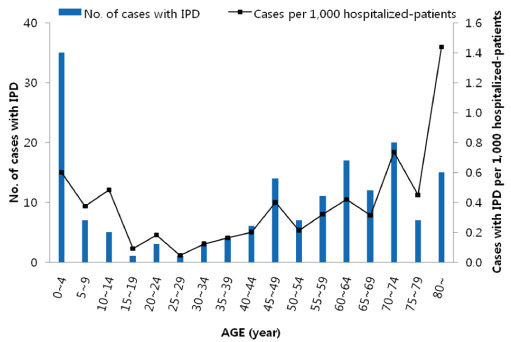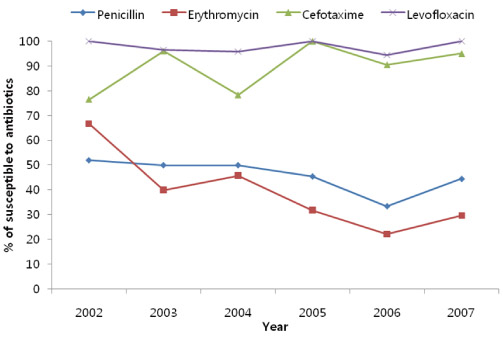Infect Chemother.
2010 Jun;42(3):156-161. 10.3947/ic.2010.42.3.156.
Clinical Features of Invasive Pneumococcal Disease in Korea
- Affiliations
-
- 1Division of Infectious Disease, Department of Internal Medicine, Korea University College of Medicine, Seoul, Korea. heejinmd@korea.ac.kr
- KMID: 2170303
- DOI: http://doi.org/10.3947/ic.2010.42.3.156
Abstract
- BACKGROUND
Streptococcus pneumoniae is one of the most important causes of pneumonia, meningitis, bacteremia, and other invasive diseases in children and adults. The 23-valent polysaccharide pneumococcal vaccine (PPV) has been recommended to adults with high risk conditions by the Korea Society of Infectious Diseases in 2007, but there is no data on the epidemiology of invasive pneumococcal disease in Korean adults to support this recommendation. Therefore, we performed a study to investigate the epidemiology of invasive pneumococcal disease in Korean population.
MATERIALS AND METHODS
We collected clinical and microbiologic data of patients diagnosed with invasive pneumococcal disease (IPD) in 3 university-hospitals located in Seoul and Gyeonggi-do from January 2002 to December 2007.
RESULTS
A total of 168 patients were diagnosed with IPD in the selected hospitals during the study period. Invasive pneumonia and meningitis were the most common forms of IPDs. The mean length of hospitalization of patients with IPD was 18.5+/-26.7 days and mortality rate of IPD was 18.6%. Among the isolates from patients with IPD, 59.7% was susceptible to penicillin and 38.3% was susceptible to erythromycin. Mortality rate of IPD increased with age and in patients with Eastern Cooperative Oncology Group performance status 4.
CONCLUSIONS
Epidemiology of IPD in Korean population was described. Further studies should be performed to secure the risk factors of invasive pneumococcal diseases and to confirm the appropriateness of recommendation for vaccination with the 23-valent PPV.
MeSH Terms
Figure
Reference
-
1. Laurichesse H, Romaszko JP, Nguyen LT, Souweine B, Poirier V, Guólon D, André M, Ruivard M, De Champs C, Caillaud D, Labbé A, Beytout J. Clinical characteristics and outcome of patients with invasive pneumococcal disease, Puy-de-Dôme, France, 1994-1998. Eur J Clin Microbiol Infect Dis. 2001. 20:299–308.
Article2. Ma JS, Chen PY, Mak SC, Chi CS, Lau YJ. Clinical outcome of invasive pneumococcal infection in children: a 10-year retrospective analysis. J Microbiol Immunol Infect. 2002. 35:23–28.3. Hsu LY, Lui SW, Lee JL, Hedzlyn HM, Kong DH, Shameen S, Siti NP, Tan WY, Toh XY, Koh TY, Koh TH. Adult invasive pneumococcal disease pre- and peri-pneumococcal conjugate vaccine introduction in a tertiary hospital in Singapore. J Med Microbiol. 2009. 58:101–104.
Article4. Ispahani P, Slack RC, Donald FE, Weston VC, Rutter N. Twenty year surveillance of invasive pneumococcal disease in Nottingham: serogroups responsible and implications for immunisation. Arch Dis Child. 2004. 89:757–762.
Article5. Lee HJ, Park JY, Jang SH, Kim JH, Kim EC, Choi KW. High incidence of resistance to multiple antimicrobials in clinical isolates of Streptococcus pneumoniae from a university hospital in Korea. Clin Infect Dis. 1995. 20:826–835.
Article6. Kim SN, Kim SW, Choi IH, Pyo SN, Rhee DK. High incidence of multidrug-resistant Streptococcus pneumoniae in South Korea. Microb Drug Resist. 1996. 2:401–406.
Article7. Song JH, Chang HH, Suh JY, Ko KS, Jung SI, Oh WS, Peck KR, Lee NY, Yang Y, Chongthaleong A, Aswapokee N, Chiu CH, Lalitha MK, Perera J, Yee TT, Kumararasinghe G, Jamal F, Kamarulazaman A, Parasakthi N, Van PH, So T, Ng TK. ANSORP Study Group. Macrolide resistance and genotypic characterization of Streptococcus pneumoniae in Asian countries: a study of the Asian Network for Surveillance of Resistant Pathogens (ANSORP). J Antimicrob Chemother. 2004. 53:457–463.
Article8. Song JH, Jung SI, Ko KS, Kim NY, Son JS, Chang HH, Ki HK, Oh WS, Suh JY, Peck KR, Lee NY, Yang Y, Lu Q, Chongthaleong A, Chiu CH, Lalitha MK, Perera J, Yee TT, Kumarasinghe G, Jamal F, Kamarulzaman A, Parasakthi N, Van PH, Carlos C, So T, Ng TK, Shibl A. High prevalence of antimicrobial resistance among clinical Streptococcus pneumoniae isolates in Asia (an ANSORP study). Antimicrob Agents Chemother. 2004. 48:2101–2107.
Article9. Korea Center for Disease Control and Prevention, Korea Medical Association, Korea Advisory Committee on Immunization Practices. Epidemiology and prevention of vaccine-preventable disease. 2006. Seoul: Korea Center for Disease Control and Prevention.10. Moberley SA, Holden J, Tatham DP, Andrews RM. Vaccines for preventing pneumococcal infection in adults. Cochrane Database Syst Rev. 2008. CD000422.
Article11. Conaty S, Watson L, Dinnes J, Waugh N. The effectiveness of pneumococcal polysaccharide vaccines in adults: a systematic review of observational studies and comparison with results from randomised controlled trials. Vaccine. 2004. 22:3214–3224.
Article12. Mangtani P, Cutts F, Hall AJ. Efficacy of polysaccharide pneumococcal vaccine in adults in more developed countries: the state of the evidence. Lancet Infect Dis. 2003. 3:71–78.
Article13. Møller K, Kronborg G, Dirksen A. Is polysaccharide pneumococcal vaccine effective in adults? Ugeskr Laeger. 2001. 163:6112–6117.14. World Health Organization(WHO). 23-valent pneumococcal polysaccharide vaccine: WHO position paper. Wkly Epidemiol Rec. 2008. 83:373–384.15. Choi EH, Lee HJ. Clinical outcome of invasive infections by penicillin-resistant Streptococcus pneumoniae in Korean children. Clin Infect Dis. 1998. 26:1346–1354.
Article16. Song EK, Lee JH, Kim NH, Lee JA, Kim DH, Park KW, Choi EH, Lee HJ. Epidemiology and clinical features of invasive pneumococcal infections in children. Korean J Pediatr Infect Dis. 2005. 12:140–148.
Article17. Vaccination for adult. The Korean Society of Infectious Diseases. 2007. Seoul: Koonja Publishing Co..18. Domínguez A, Salleras L, Cardeñosa N, Ciruela P, Carmona G, Martínez A, Torner N, Fuentes M. The epidemiology of invasive Streptococcus pneumoniae disease in Catalonia (Spain). A hospital-based study. Vaccine. 2002. 20:2989–2994.
Article19. Korea Center for Disease Control and Prevention, Seoul National University College of Medicine. Disease burden of pneumococcal infection and serotypes of Streptococcus pneumoniae in Korean children. 2006. Seoul: Korea Center for Disease Control and Prevention.20. Korean Ministry of Health and Welfare. The third Korean national health and nutrition examination survey (KNHANES III) 2005. 2006. Seoul: Korea Ministry of Health and Welfare.21. Ardanuy C, Tubau F, Pallares R, Calatayud L, Domínguez MA, Rolo D, Grau I, Martín R, Liñares J. Epidemiology of invasive pneumococcal disease among adult patients in Barcelona before and after pediatric 7-valent pneumococcal conjugate vaccine introduction, 1997-2007. Clin Infect Dis. 2009. 48:57–64.
Article22. Tsai CJ, Griffin MR, Nuorti JP, Grijalva CG. Changing epidemiology of pneumococcal meningitis after the introduction of pneumococcal conjugate vaccine in the United States. Clin Infect Dis. 2008. 46:1664–1672.
Article23. Lexau CA, Lynfield R, Danila R, Pilishvili T, Facklam R, Farley MM, Harrison LH, Schaffner W, Reingold A, Bennett NM, Hadler J, Cieslak PR, Whitney CG. Active Bacterial Core Surveillance Team. Changing epidemiology of invasive pneumococcal disease among older adults in the era of pediatric pneumococcal conjugate vaccine. JAMA. 2005. 294:2043–2051.
Article24. Wikler MA. Clinical and Laboratory Standards Institute. Performance standards for antimicrobial susceptibility testing. 18th informational supplement. CLSI document M100-S18. 2008. Wayne, PA: CLSI.
- Full Text Links
- Actions
-
Cited
- CITED
-
- Close
- Share
- Similar articles
-
- Invasive Pneumococcal Diseases in Korean Adults After the Introduction of Pneumococcal Vaccine into the National Immunization Program
- An Update on Pneumococcal Vaccination
- Indirect Effects of Pneumococcal Conjugate Vaccines in National Immunization Programs for Children on Adult Pneumococcal Disease
- Direct and Indirect Effects of Pneumococcal Protein Conjugate Vaccine
- Pneumococcal vaccine




